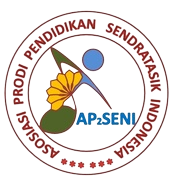PERAN MATA PELAJARAN SENI TARI DALAM PEMBENTUKAN KECERDASAN EMOSIONAL SISWA DI SEKOLAH MENENGAH ATAS
Abstract
Keywords
Full Text:
PDFReferences
Damasio, A. (1994). Descartes' Error: Emotion, Reason, and the Human Brain. New York: Grosset/Putnam.
Eisner, E. W. (2002). The Arts and the Creation of Mind. New Haven, CT: Yale University Press.
Gardner, H. (1983). Frames of Mind: The Theory of Multiple Intelligences. New York: Basic Books.
Goleman, D. (1995). Emotional Intelligence: Why It Can Matter More Than IQ. Bantam Books.
Hanna, J. L. (2008). Dancing for Health: Contributing to the Study of Dance and Health. Gainesville, FL: University Press of Florida.
Kassing, G., & Jay, D. M. (2003). Dance Teaching Methods and Curriculum Design. Champaign, IL: Human Kinetics.
Mayer, J. D., & Salovey, P. (1997). What is Emotional Intelligence? In P. Salovey & D. Sluyter (Eds.), Emotional Development and Emotional Intelligence: Educational Implications (pp. 3-31). New York: Basic Books.
Moleong, L. J. (2020). Metodologi Penelitian Kualitatif. Bandung: PT Remaja Rosdakarya.
Mulanto, J. (2015). Tari Kretek: Pewarisan Bentuk. Nilai, Dan Makna. Skripsi. Bandung: Universitas Pendidikan Indonesia Bandung.
Schutte, N. S., Malouff, J. M., Hall, L. E., Haggerty, D. J., Cooper, J. T., Golden, C. J., & Dornheim, L. (2001). Development and Validation of a Measure of Emotional Intelligence. Personality and Individual Differences, 25(2), 167-177.
Sowden, P. T. (2017). The Effects of Dance on Social and Emotional Development in Adolescents. Journal of Dance Education, 17(1), 42-54.
Zins, J. E., Weissberg, R. P., Wang, M. C., & Walberg, H. J. (2004). Building Academic Success on Social and Emotional Learning: What Does the Research Say?. New York: Teachers College Press.
DOI: https://doi.org/10.24114/gjst.v13i2.63294
Article Metrics
Abstract view : 67 timesPDF - 50 times
Refbacks
- There are currently no refbacks.
Copyright (c) 2024 Edi Sutardi, Rahmani Rahmani, Andi Wijaya

This work is licensed under a Creative Commons Attribution-ShareAlike 4.0 International License.

This work is licensed under a Creative Commons Attribution-ShareAlike 4.0 International License.

.jpg)







